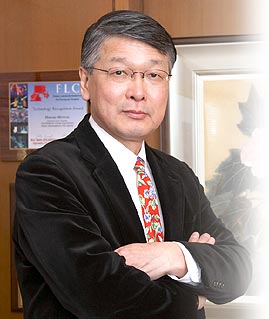
|
Program Overview > Program Members > Hiroaki, Mitsuya
|

Faculty of Life Sciences / Center for AIDS Research, Professor
AIDS & Infectious Diseases, M.D., Ph.D. Program director, Program Board member, Research & Development of AIDS therapeutics


 |
Continuing challenges in the HAART era
Currently available combination therapy or highly active antiretroviral therapy (HAART) using reverse transcriptase inhibitors (RTIs), protease inhibitors (PIs), and/or other newly developed drugs has been shown to suppress the replication of HIV-1 and extend the life expectancy of HIV-1-infected individuals and the mortality rates for HIV-infected persons have become much closer to general mortality rates since the introduction of HAART. However, an ability to provide effective long-term antiretroviral therapy for HIV-1 infection has become a complex issue since those who initially achieved favorable viral suppression to undetectable levels have experienced treatment failure. In addition, it is evident that with these anti-HIV drugs, only partial immunologic reconstitution is attained in patients with advanced HIV-1 infection.Without continuously developing further more potent, less toxic (or non-toxic), and resistance-deferring (or resistance-disallowing) antiretroviral agents, it will not be possible to improve or even maintain thus-far attained improved quality of life of patients with HIV-1 infection and AIDS. |
|
More potent and less toxic agents are in need Thus, our continuing attempt to develop more potent and less toxic antiretroviral agents will be one of the major enterprises in the global COE projects in the upcoming years. To this end, we will employ our long-standing structure-guided molecular targeting approach combining conventional cell-based assay, biochemical assays, crystallography, and molecular dynamics simulations (1, 2).
HIV-1 drug resistance is a persistent and major challenge
Dynamics of HIV-1 and HIV-1-infected cells in vivo and its alteration by treatment
|
|

| 1. | Maeda K, Das D, Yin P, Tsuchiya K, Ogata-Aoki H, Nakata H, Norman R, Hackney L, Takaoka Y, and Mitsuya H. Involvement of the second extracellular loop and transmembrane residues of CCR5 in inhibitor binding and HIV-1 fusion: Insights to mechanism of allosteric inhibition. J. Mol. Biol. 381:956-974, 2008. |
| 2. | Koh Y, Matsumi S, Amano M, Das D, Davis D, Li J, Leschenko S, Baldridge A, Shioda T, Yarchoan R, Ghosh AK, and Mitsuya H. Potent inhibition of HIV-1 replication by non-peptidyl small molecule inhibitors of HIV-1 protease dimerization. J. Biol. Chem. 282: 28709-28720, 2007. |
| 3. | Mitsuya H, Maeda K, Das D, and Ghosh AK. Development of protease inhibitors and the fight with drug-resistant HIV-1 variants. Adv. Pharmacol. 56:169-197, 2008. |
| 4. | Ghosh AK, Chapsal BD, Weber IT, and Mitsuya H. Design of HIV Protease Inhibitors Targeting Protein Backbone: An Effective Strategy for Combating Drug Resistance. Acc. Chem. Res. 41: 78-86, 2008. |
 |
 |